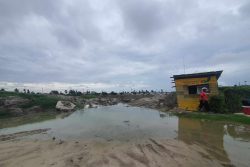Dear Editor,
An open letter to aspiring entrepreneurs: The Guyana Innovation Program is not what you think. This may surprise you. Read to find out more. Here is my wish list of 10 things the Guyana Innovation Program can do to bring meaningful tech innovation to Guyana and the wider Caribbean.
Instead of touting the Guyana Prize Program as being like “Shark Tank” – the very popular and famous television show where ferocious businessmen with a ‘Killer Instinct’ for a good deal compete against each other, it may be better to tone down the hype a bit because of the danger of building up false expectations. The local equivalent is more like fishing for ‘Bangamary’ where bureaucrats just tick off boxes that meet certain criteria. “Sharks” are real-world, hard-nose businessmen like the wolves of Wall Street who can spot a ‘Good Product Innovation’ a mile away that can make them millions. Bureaucrats on the other hand have no dog in the fight. They are only looking forward to their next month paycheck! A big difference! Whether a product fails or succeeds, they still get paid.
Would -be entrepreneurs may want to seek legal advise on the offer to participate in the program before submitting your game-changing ‘innovation’, ‘your valuable intellectual property’ for consideration. The opportunity to participate in the competition to win a non – reimbursable prize of USD $10,000 is indeed very attractive. I believe there are legal implications involved when applicants accept the offer made by GIP. Is it a legally binding agreement? Is it legally enforceable?
In its present incarnation, the program offers year long training to applicants accepted by the program. Aspiring entrepreneurs may want to seek clarification on whether attendance at and /or completion of training/coaching sessions is mandatory or optional. Also, find out if attendance at training sessions is a factor that would be used in the final evaluation of your innovation.
It may probably be a good thing to seek clarification on the status of the organization charged with managing the program. Is the Guyana Innovation Program an established and/or an accredited Training Institution? It has been touted that the coaches/trainers are persons who worked or are still working at Fortune 500 companies such as Google, Microsoft and Tesla as trainers. That may be so, but it is very unlikely that they worked there as trainers and/or coaches but were rather lower level employees. Wannabe entrepreneurs, are proactive, creative individuals who now have access to an amazing resource: Google search box. Wanna learn how to make an Elevator Pitch? Google it! Wanna know how to Estimate Market Size? Google it! As far as I know, no local trainer has the knowledge or the immense resources as Google! And, as a student said, “Why do I need a teacher, when I’ve got Google?”
What education psychologists, Human Resource Managers, and Production managers tell us, is that for training/coaching to be effective it must be based on a Training Needs Assessment. The Learning Objectives of any training must be clearly stated, as well as the Key Principles, Practices and or Procedures, Knowledge and Skills to be acquired. Or else the exercise is a waste of Time, Energy and Resources. The 27 contestants who were accepted to the program all have different levels of education and different areas of interest. A “One-size fits all approach” does not work.
How secure is your innovation? Are there any safeguards to ensure that persons involved in the program and who have access to the ‘innovations’ do not benefit materially or financially from the innovations submitted? Remember people wear social masks and all persons always act in their own self-interests.
In the interest of full transparency, are the criteria that would be used for judging submissions clearly communicated in writing to all contestants at the very beginning of the program? It is not sufficient to inform wannabees that the program would not be funding just a ‘great idea’ or a ‘tech-enabled’ product. Or, that they would be evaluated on their “Presentation” and “Work Plan”. Those are blanket terms that provide too much “wiggle room”. It lacks specificity. What leading institutions in the region and the world do is follow “Best Practice”.
Contestants are first placed in groups according to their level of development, namely “Ideation Stage” or “Early Stage” (Startups) and the judging criteria are stated with specificity, so there is very little ‘wiggle room’. It is very important that contestants be informed of the specific criteria if only to de-potentiate subsequent accusations of a lack of transparency. Using a similar approach, it would have been preferred if GIP had informed contestants that the following specific criteria would be used to evaluate their presentation. Contestants were merely informed that their ‘presentation’ would be evaluated.
Judging Criteria for the “Presentation”: 1. Introduction;
2. Problem identification; 3. Pro-posed Solution, | Value Proposition; 4. The Product; 5 Target Customers, 6. Competition/Differentiation; 7. TAM/Opportunity; 8. Marketing | Distribution, 9. Product Validation 10. How the prize money would help the project | Return on Investment. Judging Criteria for the “Work Plan”: 1. Market Research; 2. The Problem; 3. The Proposed Solution | Value Proposition; 4. Market Size; 5 Product Differentiation and Competitive Advantage; 6. Product Validation; 7. Manufacturing and Distribution; 8. Marketing and Sales; 9. Management Team and Plan.
It may be more helpful to ask wannabe entrepreneurs to make their product pitch to a group of leading businessmen rather than to a bunch of in-house bureaucrats. Instead, invite leading members of the business community to participate as judges of the innovative product. Bureaucrats can’t tell whether a product will sell. Only the market! After all, this is where the ‘great idea’ faces reality, where the rubber meets the road. Heard of the FedEx story? It is reported that a young first year undergraduate student at a top American university submitted a proposal for an aircraft delivery system for parcels and goods. The distinguished professor, then Dean of the Business School, scoffed at the idea and rejected it telling the student it would not work. The student dropped out of the university and set up his startup business which has become the now world famous FedEx overnight delivery system.
As an inspiration to wannabe entrepreneurs, GIP may find it more helpful to post past successful innovative products that they have successfully helped bring to market. What problems did it help solve for Guyanese? How many units of the product were sold? How much money did it make? A quick “Litmus Test” of the success of past incarnations is to ask oneself: What innovative product won the competition last year, or whenever? Is it a big seller? If you can readily answer that question then the Guyana Innovation Programme has done a great job. I look forward to seeing what this year’s innovation is.
Sincerely,
(Name and Address Provided)






